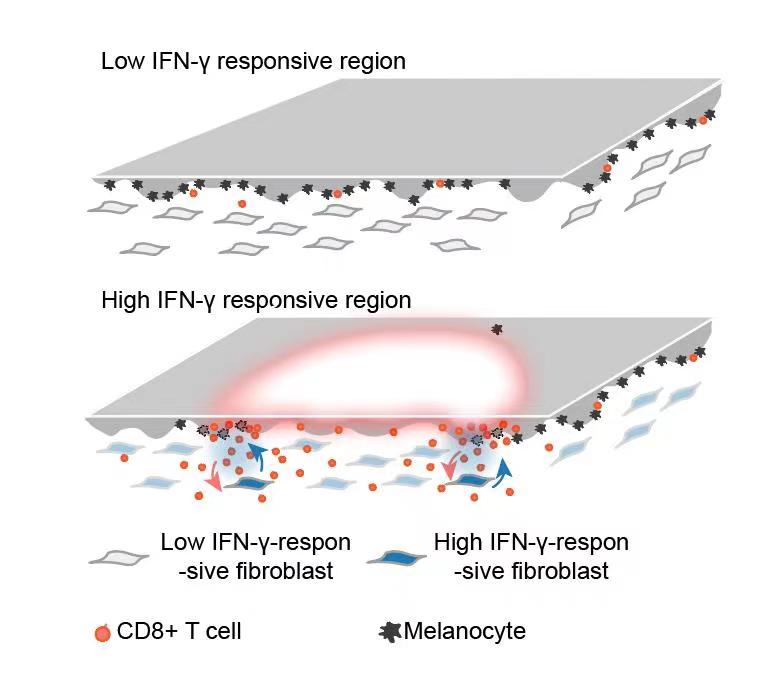Dr. Ting Chen’s group revealed the symmetric pathogenesis pattern of autoimmune skin disease vitiligo
Source:Ting Chen
2022-03-21
Dr. Ting Chen’s group from National institute of Biological Sciences/Tsinghua Institute of Multidisciplinary Biomedical Research published a research article in Nature on Jan 6th, 2022, entitled “Anatomically distinct fibroblast subsets determine skin autoimmune patterns”. This study revealed the dermal fibroblasts were required to recruit and activate CD8+ cytotoxic T cells through secreted chemokines and drive the organ level lesion patterns in the autoimmune disease vitiligo. Further study indicated anatomically distinct human dermal fibroblasts exhibited intrinsic differences in the expression of chemokines in response to IFN-γ, which resulted in the regional and symmetric patterns of vitiligo.
Vitiligo is a skin autoimmune disease, afflicting 0.5% to 2% of the worldwide population. The defining feature of Vitiligo is skin depigmentation, owing to auto-reactive CD8+ T cells targeting epidermal melanocytes. Vitiligo patients exhibit regional pattern and bilateral symmetric patterns of depigmentation. Despite several studies, the cellular and molecular mechanisms that orchestrate patterned immune cell activities in vitiligo patients’ skin remain elusive. Dr. Ting Chen’s group carried out single cell RNA-seq to analyze skin local cells. Among eight different cell types, they identified dermal fibroblasts accounted for most of the IFN-γ responses and T cell migration. Through three robust mouse model of vitiligo and mouse genetic studies, they demonstrated IFN-γ-responsive skin dermal fibroblast was essential for local recruitment and cytotoxicity of CD8+ T cells targeting melanocyte.
To study the molecular mechanism of fibroblast mediated vitiligo progression, Dr. Ting Chen’s group used transwell assay and in vivo regional fibroblast knockdown techniques, and finally identified that IFN-γ-responsive fibroblasts mediated local aggregation and activation of CD8+ T cells through the CXCL9 and CXCL10. Further study indicated the expression of CXCL9 and CXCL10 in response to IFN-γ varied significantly among regional-specific fibroblasts. CXCL9 and CXCL10 were significantly upregulated in fibroblasts that were isolated from anatomic regions with a higher incidence of vitiligo, like hand back. While in the region with a lower incidence of vitiligo, like palm, the upregulation of CXCL9 and CXCL10 were relative lower. Further correlation analysis in mouse model also showed that regional variation in fibroblasts IFN-γ-responsive abilities could result in patterned T cell activity and vitiligo progression.
 The discovery provides a general paradigm through which the regional pattern of skin autoimmune diseases are regulated. The study also provides new insights for the regulatory mechanism of many other autoimmune skin diseases in addition to vitiligo, which exhibits regional preference with symmetric distributions. Dr. Zijian Xu and Dr. Daoming Chen from National institute of Biological Sciences are the co-first author of this article. Dr. Jianmin Chang from Beijing Hospital and Dr. Ting Chen from National institute of Biological Sciences are the corresponding authors of this article. This work was funded by the grants from the National Key R&D Program of the Ministry of Science and Technology, the National Basic Research Program of China 973 Programs, National Nature Science foundation of China, and the Beijing Municipal Natural Science Foundation.
The discovery provides a general paradigm through which the regional pattern of skin autoimmune diseases are regulated. The study also provides new insights for the regulatory mechanism of many other autoimmune skin diseases in addition to vitiligo, which exhibits regional preference with symmetric distributions. Dr. Zijian Xu and Dr. Daoming Chen from National institute of Biological Sciences are the co-first author of this article. Dr. Jianmin Chang from Beijing Hospital and Dr. Ting Chen from National institute of Biological Sciences are the corresponding authors of this article. This work was funded by the grants from the National Key R&D Program of the Ministry of Science and Technology, the National Basic Research Program of China 973 Programs, National Nature Science foundation of China, and the Beijing Municipal Natural Science Foundation.
Links: https://www.nature.com/articles/s41586-021-04221-8
Vitiligo is a skin autoimmune disease, afflicting 0.5% to 2% of the worldwide population. The defining feature of Vitiligo is skin depigmentation, owing to auto-reactive CD8+ T cells targeting epidermal melanocytes. Vitiligo patients exhibit regional pattern and bilateral symmetric patterns of depigmentation. Despite several studies, the cellular and molecular mechanisms that orchestrate patterned immune cell activities in vitiligo patients’ skin remain elusive. Dr. Ting Chen’s group carried out single cell RNA-seq to analyze skin local cells. Among eight different cell types, they identified dermal fibroblasts accounted for most of the IFN-γ responses and T cell migration. Through three robust mouse model of vitiligo and mouse genetic studies, they demonstrated IFN-γ-responsive skin dermal fibroblast was essential for local recruitment and cytotoxicity of CD8+ T cells targeting melanocyte.
To study the molecular mechanism of fibroblast mediated vitiligo progression, Dr. Ting Chen’s group used transwell assay and in vivo regional fibroblast knockdown techniques, and finally identified that IFN-γ-responsive fibroblasts mediated local aggregation and activation of CD8+ T cells through the CXCL9 and CXCL10. Further study indicated the expression of CXCL9 and CXCL10 in response to IFN-γ varied significantly among regional-specific fibroblasts. CXCL9 and CXCL10 were significantly upregulated in fibroblasts that were isolated from anatomic regions with a higher incidence of vitiligo, like hand back. While in the region with a lower incidence of vitiligo, like palm, the upregulation of CXCL9 and CXCL10 were relative lower. Further correlation analysis in mouse model also showed that regional variation in fibroblasts IFN-γ-responsive abilities could result in patterned T cell activity and vitiligo progression.

Links: https://www.nature.com/articles/s41586-021-04221-8


